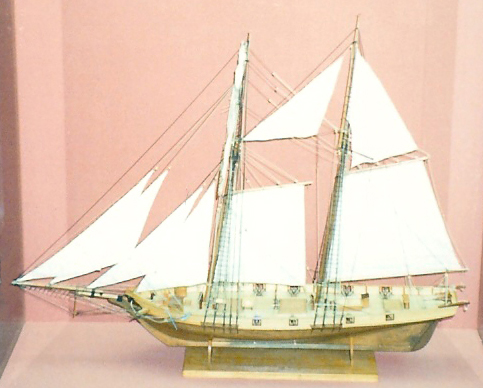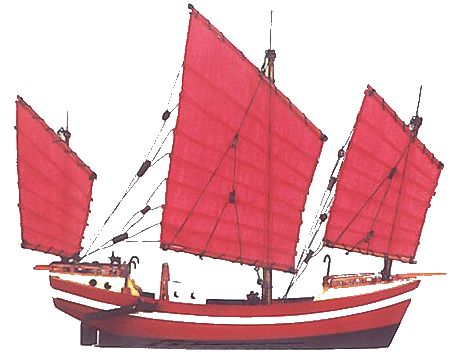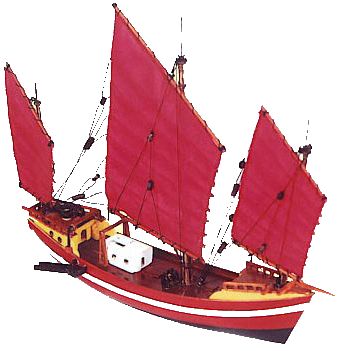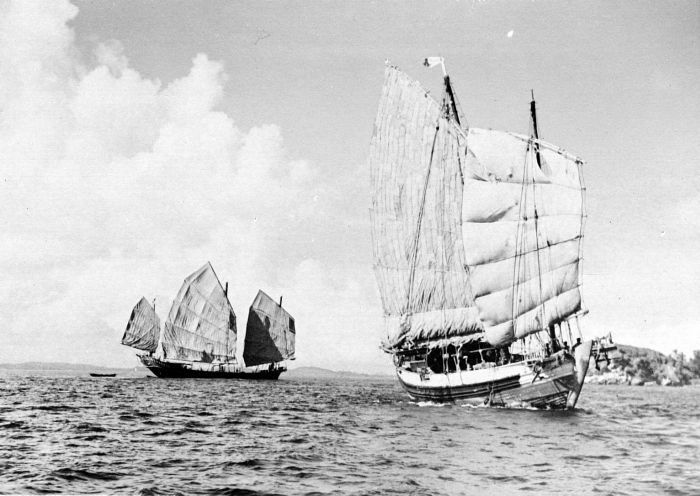The Fighting Lorchas of Macau
The Lorcha which was so much a part of Macau's maritime scene and it's rich history is still commemorated today in Macau's cuisine by one of it's more popular dishes – Amargoso Lorcha.
These gallant little fighting ships were designed in Macau, by Macaenses, for Macau. They incorporated the finest of Portuguese and Chinese naval architecture of that time and were built specifically as fighting ships operating against pirates, as coast guard and for convoy duty. They were built in the Porto Interior (Inner Harbour) of Macau, mainly of teak [and camphor-wood] with a flat bottom and very light draft. The stern and rudder were of Chinese design and the vessel was well adapted for tacking about quickly. As a rule they were two-masted, with lateen as well as round sails. Their size ranged from 40 to 150 tons, but in the main they were from 50 to 100 tons. The smaller lorchas carried four to six guns and larger ones were equipped with twenty guns– – from 1- to 24-pounders, the lighter pieces on swivels. Half of their crew were Portuguese and the other half Chinese, all well armed with muskets, swords and spears.
The lorchas were gaily painted and brightened up Macau's harbour. According to the historian Montalto Jesus the lorchas were Macau's best hope during the mid-19th century. He wrote,2
"constituting as they did a pledge of her (Macau's) welfare economically as well as politically. And acting for the same cause which shed lustre on the colony's origin, the Macaenses showed that they had not lost the mettle of their historical forefathers in fighting pirates and thereby winning China's goodwill for Macau."
The lorchas ventured everywhere along the China coast and the mandarins employed them for their own protection as well as for escort duty for their traders and fishermen. Their convoy duties took them as far as Taiwan, Korea and Japan. They were even known to have crossed the Pacific to California! At that time the pirates totally controlled the coast, and the mandarins and traders in general were held to ransom by these brigands. It was only when supported and assisted by our lorchas did the mandarins attain victories against the pirates.
The work of those manning the lorchas. although very perilous, was extremely lucrative and undoubtedly assisted immensely in the economy of Macau. The success of the lorchas eventually led to jealousy amongst the British, French and others who instigated the massacre of the Portuguese at Ningpo on June 26, 1857 by the Chinese, supported by foreign privateers. An assault was made on all Portuguese ashore and afloat, the Portuguese consulate was pillaged and wrecked, the flag hauled down and trampled on. The British Consulate drove out Portuguese refugees seeking shelter there, to be butchered or slowly tortured to death.
The lorcha was something very special to the Macaense; it was made up of the best of the east and of the west – like Macau. Its role has at times been misconstrued. It was never a fishing boat and certainly not a Chinese junk. Many of our forefathers were lorcha captains. Manuel Joaquim Baptista, the father of the famous Macaense artist, Marciano Baptista, was one of them.3
Unfortunately , there is little recorded information as to the names of the lorcha captains and their accomplishments. The men who sailed their ships did not leave any records of their adventures. Some of the old tales were passed on only from father to son and hence, sad to say, a rich chapter in Macau's history has been lost forever.
An action of a Portuguese lorcha that was recorded is that of the "Amazona". A joint naval expedition made up of British. American, Portuguese and Chinese forces under the command of Captain O'Callahan of the Royal Navy was planned and launched from Hong Kong on August 3, 1855, against a strong fleet of piratical junks operating from the Island of Kuhlan, some sixty miles south-west of Macau. The Portuguese contribution to this multinational force was the lorcha "Amazona", with a naval detachment under the command of Lieut. Commander José da Silva Carvalho. The American contribution was the steamed vessel, the USS Rattler.
The operation was a very difficult one as the sea approaches were defended by a large fleet of well-armed junks and the hilly condition of the island favoured the pirates. In the ensuing battles many of the pirates were killed or captured. Fifty junks were sunk and the fortified batterie ashore, comprising twenty-seven guns, were destroyed. The pirates had put up a determined resistance and it took the allied forces seven days to subdue them.
A British officer's eye-witness report of the battle related that the Portuguese and the Americans were conspicuous in the action. The Portuguese naval detachment operated in conjunction with the British Royal Marines in clearing the island of pirates. Lieut. Commander José da Silva Carvalho and the valiant crew of the Amazona were publicly thanked by the commander of the expedition, Captain O'Callahan.
The Amazona's brilliant exploits in the shallow waters around Macau as far north as Ningpo were legendary. She was considered one of the finest combat vessels under sail on the South China coast at that time. Due to her shallow draft and excellent sailing qualities, she was able to swiftly attack pirates' lairs and destroy their vessels and villages. Her commander, Lieut. Commander Silva Carvalho, was highly commended by the British and French admirals, and by the Chinese officials, for the magnificent service he and his crew rendered against the pirates of the China coast. It is sad to note that this gallant lorcha ended her days as a depot ship for the water police in the Mozambique River.
With the advent of steam the lorcha soon faded away and is today only remembered by the dish Amargoso Lorcha. There are many variations to this recipe and one is included in the recipes.
1 This is an edited version of an article first published in the Bulletin of Casa de Macau (Australia).
2 CA Montalto de Jesus, Historic Macao, Oxford University Press 1984, p382
3 Montalto de Jesus records the names and exploits of only two lorcha commanders: António Gonçalves Carocha (a Macaense pilot) of the Leão, and José da Silva Carvalho of the Amazona.



